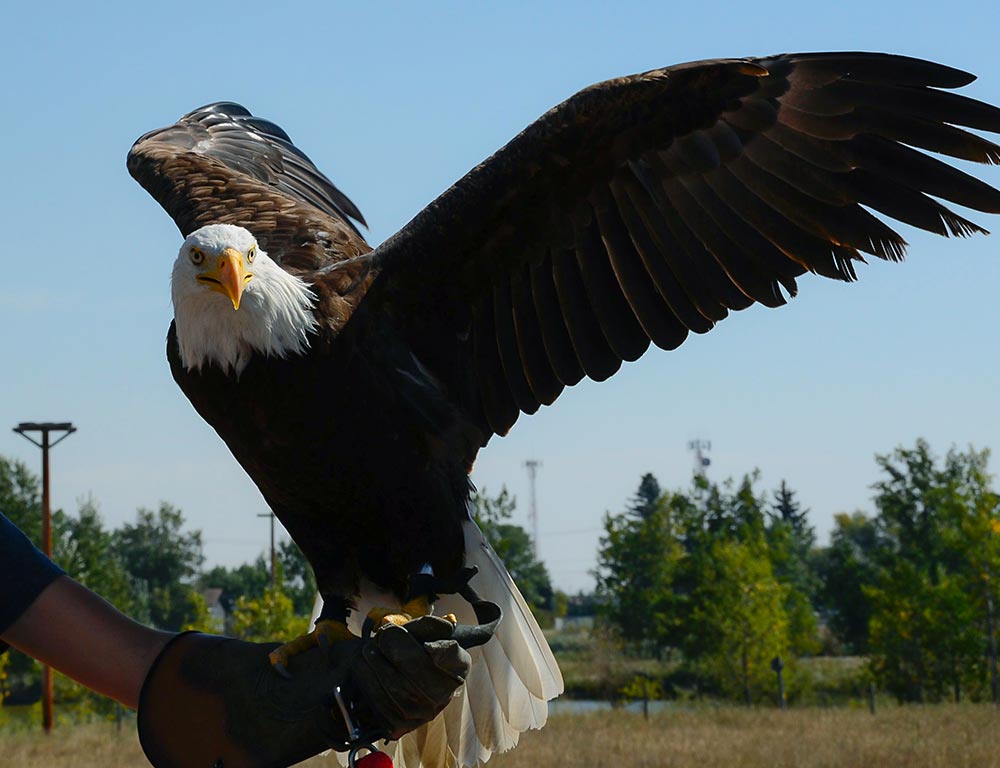In Illinois, the presence of eagles graces the state with both cultural significance and ecological importance. The Bald Eagle (Haliaeetus leucocephalus) is a prominent symbol that symbolizes freedom and strength.
Once on the brink of extinction, these regal birds have made a remarkable comeback in Illinois.
The state’s abundant waterways, including the Mississippi and Illinois Rivers, serve as prime habitats for these raptors, providing rich hunting grounds and suitable nesting sites.
Observing eagles in flight or perched along riverbanks has become a captivating spectacle for residents and nature enthusiasts. Beyond their aesthetic appeal, eagles play a crucial role in maintaining ecological balance by controlling local prey populations.
Understanding the symbiotic relationship between eagles and Illinois’ diverse landscapes sheds light on the resilience of both the species and the state’s natural heritage.
Is Illinois A Good Place for Eagles?
Illinois is an excellent habitat for eagles, offering a combination of diverse landscapes and abundant waterways that cater to the specific needs of these majestic birds of prey.
Here are five descriptive points highlighting why Illinois is a favorable place for eagles:
Rich Waterways
Illinois is crisscrossed by several major rivers, including the Mississippi, Illinois, and Kaskaskia.
These water bodies provide a consistent food source for eagles, as they thrive on a diet primarily consisting of fish. The abundance of rivers creates an ideal environment for eagles to hunt and find sustenance.
Varied Habitats
From wetlands and marshes to wooded areas along riverbanks, Illinois offers a diverse range of habitats that cater to the different needs of eagles.
These habitats provide suitable nesting sites, ensuring a balanced ecosystem that supports the eagles throughout their life cycle.
Seasonal Migration
Illinois serves as a crucial stopover point for eagles during their seasonal migrations.
The state’s geography and water resources make it an attractive location for eagles traveling between their breeding and wintering grounds. This seasonal influx enhances the state’s eagle population during specific times of the year.
Conservation Efforts
Illinois has actively participated in conservation programs to protect and rehabilitate eagle populations.
Efforts to preserve natural habitats, regulate environmental pollution, and manage wildlife areas have contributed to the successful recovery of the Bald Eagle, once endangered in the region.
Scenic Landscapes
The picturesque landscapes of Illinois, especially along its rivers and lakeshores, provide a visually stunning backdrop for eagle-watching.
Residents and visitors alike can witness these powerful birds in flight or perched along the scenic waterways, creating a unique and captivating experience that fosters appreciation for both wildlife and the state’s natural beauty.
The combination of rich waterways, varied habitats, seasonal migration patterns, conservation initiatives, and scenic landscapes make Illinois an ideal and thriving habitat for eagles, contributing to the continued success of these iconic birds in the region.
2 Types of Eagles in Illinois
Illinois boasts a majestic presence of eagles, particularly the iconic Bald Eagle, symbolizing freedom and strength. Once endangered, these regal birds have rebounded, enriching the state’s landscapes.
Their resurgence is a testament to conservation success and the thriving ecosystems along Illinois’ waterways.
1. Bald Eagle

- Scientific Name: Haliaeetus leucocephalus
- Category: Sea and Fish Eagles
- Population: Increasing
- Life Span: Up to 28 years in the wild
- Size: 28-40 inches (length)
- Weight: 6.5-14 pounds
- Food: Mainly fish, birds, and small mammals
- Wingspan: 6.1 to 7.0 feet
- Status: Least Concern (Protected under the Bald and Golden Eagle Protection Act)
The Bald Eagle, a symbol of American strength and freedom, is a distinguished resident of Illinois. Its distinctive white head and tail thrive near open water bodies.
The population of Bald Eagles in Illinois is increasing thanks to conservation efforts and the banning of harmful pesticides like DDT. Bald Eagles exhibit impressive lifespans of up to 28 years in the wild.
Their substantial size, ranging from 28 to 40 inches, and weight between 6.5 to 14 pounds make them formidable predators. Predominantly piscivorous, they feed on fish but also consume birds and small mammals.
Their powerful talons and hooked beaks aid in hunting and catching prey. Bald Eagles build large nests in trees near water, contributing to their survival and reproductive success.
Classified as “Least Concern,” the Bald Eagle is protected by legislation, ensuring its continued presence and conservation in Illinois.
2. Golden Eagle

- Scientific Name: Aquila chrysaetos
- Category: True Eagles
- Population: Stable
- Life Span: Up to 30 years in the wild
- Size: 27-33 inches (length)
- Weight: 6.6-15 pounds
- Food: Mainly mammals, including rabbits and ground squirrels
- Wingspan: 6.0 to 7.5 feet
- Status: Least Concern
With its golden-brown plumage, the Golden Eagle is a majestic and adaptable predator in Illinois. These true eagles thrive in various habitats, including open country and mountains. Golden Eagles exhibit remarkable lifespans of up to 30 years in the wild.
Their size, ranging from 27 to 33 inches in length, and a weight varying between 6.6 to 15 pounds, showcases their adaptability.
Primarily carnivorous, Golden Eagles mainly feed on mammals, favoring rabbits and ground squirrels.
Their strong talons and sharp beaks make them adept hunters. Golden Eagles build nests on cliffs or elevated locations for nesting and raising their young.
Classified as “Least Concern,” the Golden Eagle’s stable population in Illinois is supported by conservation efforts and their ability to adapt to various landscapes.
Their significant role in ecological balance underscores the importance of their conservation and protection.
Best Places in Illinois to Spot Eagles?
Illinois offers several prime locations for eagle watching, allowing enthusiasts to witness these majestic birds in their natural habitats. Here are some of the best places in Illinois to spot eagles:
Starved Rock State Park
Located along the Illinois River, Starved Rock State Park is renowned for its towering cliffs and canyons. During winter, eagles gather near the dam, providing excellent viewing opportunities.
Mississippi Palisades State Park
Situated along the bluffs of the Mississippi River, this park is a hotspot for eagle-watching. The expansive river views and wooded areas offer a perfect environment for eagles to hunt and nest.
Pere Marquette State Park
Nestled along the Great River Road, Pere Marquette State Park is known for its river overlooks. Eagles are frequently spotted near the confluence of the Mississippi and Illinois Rivers, especially during the winter.
Emiquon National Wildlife Refuge
Restored wetlands at Emiquon provide an ideal habitat for eagles. The refuge, located along the Illinois River, attracts eagles seeking food in the diverse aquatic ecosystems.
Cairo
Positioned at the southern tip of Illinois where the Ohio and Mississippi Rivers meet, Cairo is a convergence point for eagles during the winter. The open waters and abundant fish make it a favorable location for these birds.
Hennepin Canal Parkway State Park
Along the Hennepin Canal, eagle watchers can enjoy scenic views while observing eagles hunting for fish in the water. The canal’s linear nature provides accessible vantage points for visitors.
Illinois Waterway Visitor Center
Situated near the Starved Rock Lock and Dam, this visitor center offers an educational experience along with great views of eagles. The dam attracts eagles due to the concentration of fish in the turbulent waters.
Lake Shelbyville
In central Illinois, Lake Shelbyville provides a mix of open water and wooded areas. Eagles are often seen around the lake; winter boat tours offer a unique eagle-watching perspective.
Illinois Audubon Society’s Plum Island Sanctuary
Plum Island Sanctuary is a protected area located on the Illinois River that attracts eagles. Accessible by boat, one can witness eagles in a more secluded environment.
Fox River
The Fox River and its tributaries offer excellent eagle-watching opportunities, particularly in northern Illinois. The combination of open water and wooded landscapes makes it a favored region for these birds.
Whether along rivers, in state parks, or at wildlife refuges, these locations showcase the diverse ecosystems of Illinois, providing enthusiasts with the chance to witness eagles in their natural habitats.
How to Increase the Number of Eagles in Illinois?
Increasing the number of eagles in Illinois involves a combination of habitat preservation, conservation efforts, and public awareness. Here are several strategies to promote the growth of the eagle population in the state:
Habitat Conservation
Preserve and enhance existing eagle habitats, particularly along rivers, lakes, and wetlands where eagles find suitable nesting sites and ample food sources.
Collaborate with landowners, conservation organizations, and government agencies to implement habitat restoration projects that benefit eagles.
Water Quality Management
Implement measures to maintain and improve water quality in rivers and lakes. Reducing pollution helps ensure a healthy aquatic ecosystem and an abundant supply of fish, a primary food source for eagles.
Conservation Education
Raise awareness about eagles and their importance in the ecosystem through educational programs, workshops, and outreach initiatives targeting schools, communities, and nature enthusiasts.
Encourage responsible eagle watching, emphasizing the importance of maintaining a respectful distance to avoid disturbance to nesting sites.
Monitoring and Research
Regularly monitor and research to track eagle populations, nesting success, and potential threats. This data can inform conservation strategies and help identify emerging issues that need attention.
Collaborative Conservation Programs
Foster partnerships between government agencies, conservation organizations, and private landowners to develop and implement effective conservation programs that support eagle populations.
Regulatory Protection
Enforce and strengthen regulations that protect eagles and their habitats. This includes laws related to habitat destruction, pollution control, and disturbance near nesting sites.
Artificial Nesting Platforms
Install and maintain artificial nesting platforms in suitable locations. These structures can supplement natural nesting sites, allowing eagles to raise their young.
Monitoring Power Line Collisions
Collaborate with utility companies to monitor and mitigate the impact of power line collisions, which can threaten eagles. Implement measures such as marking power lines or adjusting their locations to reduce collision risks.
Community Engagement
Involve local communities in eagle conservation efforts. Engaged communities are likelier to take pride in their natural heritage and actively contribute to eagle protection measures.
By combining these strategies, Illinois can create a conducive environment for eagle populations to thrive. It requires a coordinated effort from various stakeholders to ensure the long-term success of eagle conservation in the state.
Wrapping Up
Safeguarding the majestic eagles of Illinois demands a holistic approach that balances habitat preservation, public awareness, and collaborative conservation efforts.
By focusing on the preservation of diverse ecosystems, water quality management, and responsible community engagement, Illinois can continue to be a haven for these iconic birds.
Ongoing research and monitoring will be pivotal in adapting strategies to evolving challenges and ensuring the sustained growth of eagle populations.
The success of such initiatives not only safeguards a vital species but also contributes to the overall health and resilience of Illinois’ unique natural heritage.